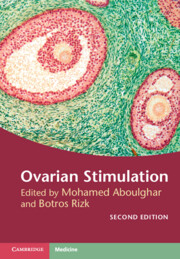Book contents
- Ovarian Stimulation
- Ovarian Stimulation
- Copyright page
- Dedication
- Contents
- Contributors
- About the Editors
- Foreword
- Preface to the first edition
- Preface to the second edition
- Section 1 Mild Forms of Ovarian Stimulation
- Section 2 Ovarian Hyperstimulation for IVF
- Section 3 Difficulties and Complications of Ovarian Stimulation and Implantation
- Chapter 12 Ovarian Stimulation in Difficult IVF Cases
- Chapter 13 Polycystic Ovary Syndrome: Ovulation Induction Strategies
- Chapter 14 Polycystic Ovary Syndrome: Controlled Ovarian Stimulation
- Chapter 15 Prevention of Ovarian Hyperstimulation Syndrome
- Chapter 16 Treatment of Ovarian Hyperstimulation Syndrome
- Chapter 17 How to Individualize Ovarian Stimulation Protocols to Avoid Difficulties and Complications
- Chapter 18 Endometrial Receptivity
- Chapter 19 Folliculogenesis and Implantation Failure
- Section 4 Non-conventional Forms Used during Ovarian Stimulation
- Section 5 Alternatives to Ovarian Hyperstimulation and Delayed Transfer
- Section 6 Procedures before, during, and after Ovarian Stimulation
- Index
- References
Chapter 19 - Folliculogenesis and Implantation Failure
from Section 3 - Difficulties and Complications of Ovarian Stimulation and Implantation
Published online by Cambridge University Press: 14 April 2022
- Ovarian Stimulation
- Ovarian Stimulation
- Copyright page
- Dedication
- Contents
- Contributors
- About the Editors
- Foreword
- Preface to the first edition
- Preface to the second edition
- Section 1 Mild Forms of Ovarian Stimulation
- Section 2 Ovarian Hyperstimulation for IVF
- Section 3 Difficulties and Complications of Ovarian Stimulation and Implantation
- Chapter 12 Ovarian Stimulation in Difficult IVF Cases
- Chapter 13 Polycystic Ovary Syndrome: Ovulation Induction Strategies
- Chapter 14 Polycystic Ovary Syndrome: Controlled Ovarian Stimulation
- Chapter 15 Prevention of Ovarian Hyperstimulation Syndrome
- Chapter 16 Treatment of Ovarian Hyperstimulation Syndrome
- Chapter 17 How to Individualize Ovarian Stimulation Protocols to Avoid Difficulties and Complications
- Chapter 18 Endometrial Receptivity
- Chapter 19 Folliculogenesis and Implantation Failure
- Section 4 Non-conventional Forms Used during Ovarian Stimulation
- Section 5 Alternatives to Ovarian Hyperstimulation and Delayed Transfer
- Section 6 Procedures before, during, and after Ovarian Stimulation
- Index
- References
Summary
Following fertilization in the fallopian tube approximately 24 to 48 hours after ovulation, the zygote migrates through the fallopian tube to the uterine cavity at the stage of morula on day 18 of an ideal 28-day cycle [1]. On day 19, a 32- to 256-cell blastocyst forms, sheds its zona pellucida (known as hatching), superficially apposes, and adheres to the endometrium [2]. This is followed by trophoblast invasion through the endometrial epithelium and underlying stroma, the inner third of the myometrium, and the uterine vasculature, all of which finally result in placentation [3]. The success of each step is crucial in order to advance toward the next stage.
- Type
- Chapter
- Information
- Ovarian Stimulation , pp. 182 - 188Publisher: Cambridge University PressPrint publication year: 2022



